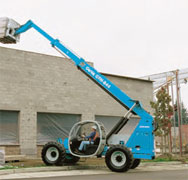 A Genie telehandler. |
Five years after being acquired by Terex Corp, telehandler manufacturer Genie Industries is rapidly changing into a global company.
Steve Wilhelm writes in
Puget Sound Business Journal that Genie is "stretching in new directions" to sell its machines worldwide.
Genie makes up 75% of Terex's aerial work platform division, which grew 41% from 2005 to 2006 and made USD1.7 billion sales in the first nine months of fiscal 2007. Terex, headquartered in Westport, Connecticut, grew 20% from 2005 to 2006 with USD7.6 billion in sales.
The company employs 3,200 people in Redmond and 5,000 worldwide. Its 10 leased buildings cover 843,350 square feet (78,350 square metres). In January, Genie opened a boom production line in Italy, where it will soon open a second plant. It is also preparing to start scissor lift production in the UK and expects to manufacture in Asia by 2009.
"We're making the transition from Genie being a company ... toward philosophically thinking about Genie being a brand. That's a big transition to make for an organisation," says Genie president Tim Ford.
"Around here, this globalisation thing is new, difficult and uncomfortable," he says. "When the company was growing up it was all here. We [now] have customers around the world demanding us and requiring us to serve them more locally."
Ford expects that most US manufacturing will continue at the Redmond site. He says the plant will take on new roles as the research and development centre for the company.
While Genie manufactures material lifting equipment like telehandlers, its main business is in people-lifting equipment. According to the
Journal, Genie and JLG Industries Inc of McConnellsburg, Pennsylvania, each control about 40% of the global people-lifting equipment market.